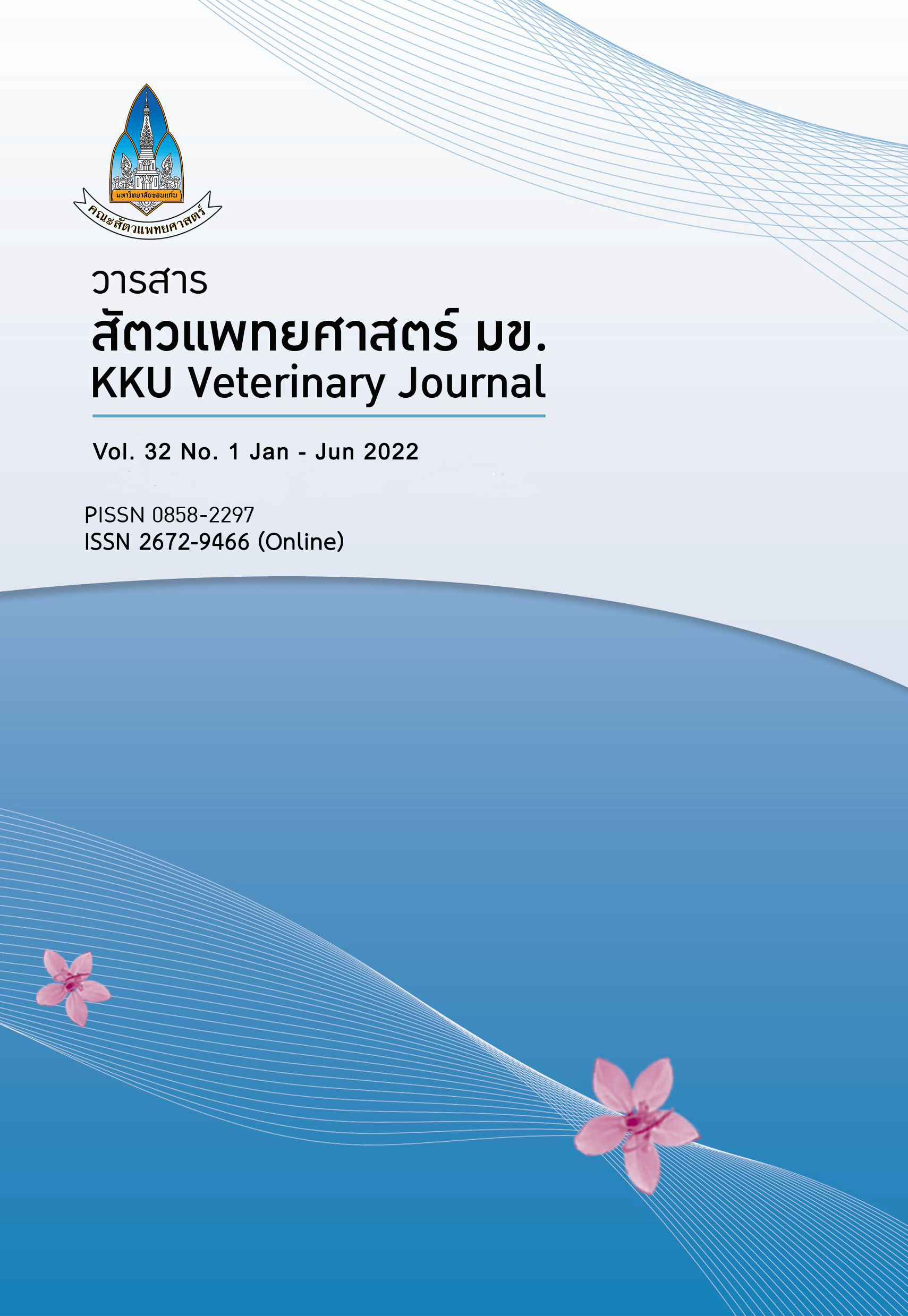Lesion scores, oocysts output, hematological and histopathological changes of the 7 days life cycle of Eimeria tenella in broilers.
Main Article Content
Abstract
Objective: Eimeria tenella is a protozoan which is a causative agent of avian cecal coccidiosis. The disease results in bleeding, diarrhea, weight loss, high morbidity and mortality in chickens. This study investigated lesion scores, oocysts output, hematological and histopathological changes of the 7 days life cycle of E. tenella.
Materials and Methods: Fifty-six, broilers were randomly divided into 2 groups of which group 1 was uninfected and group 2 was infected with 2x104E. tenella oocysts. Blood samples were collected from four chickens of each group and birds were then euthanized at 1, 2, 3, 4, 5, 6 and 7 days post infection (dpi). Lesion scores, oocyst output and hematological data were evaluated and compared between group.
Results: Lesion scores and oocyst output of the infected group were significantly higher than in the uninfected group at 5, 6 and 7 dpi (p ≤ 0.05). PCV was significantly lower than in the uninfected group at 3 to 7 dpi (p ≤ 0.05). WBC count was significantly higher than in the uninfected group at 4 dpi (p ≤ 0.05). Lymphocytes and heterophils were significantly higher compared to the uninfected group at 4 dpi (p ≤ 0.05). Monocytes were significantly higher than in the uninfected group from 3 to 5 dpi (p ≤ 0.05). The developmental stages of E. tenella in cecal tissue during the 7 days life cycle included trophozoite at 2 dpi, first generation of schizonts at 3 dpi, secondary generation of merozoites and schizonts at 4 and 5 dpi and gametocytes and oocysts at 6 and 7 dpi.
Conclusion: These findings suggest that monocytes were the most effective white blood cell and secondary generation schizonts were the pathogenic developmental stage of E. tenella which effective on lesion scores, hematological and histopathological changes was on E. tenella infection.
Article Details

This work is licensed under a Creative Commons Attribution-NonCommercial-NoDerivatives 4.0 International License.
References
Abdelrazek Y Desouky, Mohamed A Mohamed, Khaled Sultan, Nagwa M. Elhawary, Noha Ibrahim Ammar, 2020. Levamisole hydrochloride as immunostimulant drug synergies the effect of Eimeria tenella lab-made vaccine: Experimental trial. Asian J Anim Sci 14, 54-60.
Adamu M, Boonkaewwan C, Gongruttananun N, Vongpakorn M, 2013. Hematological, biochemical and histopathological changes caused by Coccidiosis in chickens. Kasetsart J (Nat Sci) 47, 238-46.
Akhtar M, Awais MM, Anwar MI, Ehtisham-ul-Haque S, Nasir A, Saleemi MK. 2015. The effect of infection with mixed Eimeria species on hematology and immune responses following Newcastle disease and infectious bursal disease booster vaccination in broilers. Vet Q 35(1), 21-6.
Awad W, Ghareeb K, Böhm J, 2008. Intestinal structure and function of broiler chickens on diets supplemented with a synbiotic containing Enterococcus faecium and oligosaccharides. Int J Mol Sci 9(11), 2205-16.
Bessay M, Vern YL, Kerboeuf D, Yvore P, Quere P, 1996. Changes in intestinal intraepithelialand systemic T-cell sub populations after an Eimeria infection in chickens: Comparative study between E. acervulina and E. tenella. Vet Res 27, 503–514.
Byrnes S, Eaton R, Kogut M, 1993. In vitro interleukin-1 and tumor necrosis factor-alpha production by macrophages from chickens infected with either Eimeria maxima or Eimeria tenella. Int J Parasitol 23, 639–645.
Cha JO, Zhao J, Yang MS, Kim WI, Cho HS, Lim CW, 2018. Oocyst-shedding patterns of three Eimeria species in chickens and shedding pattern variation depending on the storage period of Eimeria tenella oocysts. J Parasitol 104(1),18-22.
Dial AJRaSM. 2010. Abnormalities in the Red and Whites Blood Cell Populations. In: Clinical Pathology for the Veterinary Team. USA.
Donal P, Conway MEM. 2007. Poultry Coccidiosis: Diagnostic and Testing Procedures, Wiley-Blackwell, USA.
Györke A, Kalmár Z, Pop LM, uteu OL, 2016. The economic impact of infection with Eimeria spp. in broiler farms from Romania. R Bras Zootec 45, 273-80.
Hector M, Cervantes LRM, Mark CJ. 2020. Coccidiosis. In: Diseases of Poultry, 14 edn. John Wiley & Sons Inc., USA.
James GB, Hany ME, Tosson AM, 2009. Avian coccidiosis: the basic pathology to control. Egypt Soc Parasitol 39(1), 85-98.
Johnson J, Reid WM, 1970. Anticoccidial drugs: Lesion scoring techniques in battery and floor-pen experiments with chickens. Experimental Parasitology. 28(1), 30-6.
Jones MP, 2015. Avian hematology. Vet Clin North Am Exot Anim Pract 18(1), 51-61.
Kaewthamasorn M, Charoenvisal N, Chansiripornchai N. 2015. Efficacy of Salinomycin, Robenidine and Decoquinate against infection with Eimeria species field isolate in a densely populated broiler farm in Thailand. Thai J Vet Med 45, 247-53.
McKenzie ME, Johnson J, Long PL, 1985. Lethality of intestinal tissue extracts from Eimeria-infected chickens. Parasitology 90(3), 565-72.
Mitchell EB, Johns J, 2008. Avian hematology and related disorders. Vet Clin North Am Exot Anim Pract 11(3), 501-22.
Qureshi MA, 2003. Avian macrophage and immune response: an overview. Poult Sci 82(5), 691-8.
Rosales C, Demaurex N, Lowell CA, Uribe-Querol E, 2016. Neutrophils: Their Role in Innate and Adaptive Immunity. J Immunol Res 1469780.
Samour J. 2006. Diagnostic value of hematology. Clinical Avian Medicine. 587-610.
Scanes CG. 2015. Blood. In: Scanes CG (ed) Sturkie's Avian Physiology, 6 edn. Academic Press, San Diego.
Sharma S, Azmi S, Iqbal A, Nasirudullah N, Mushtaq I, 2015. Pathomorphological alterations associated with chicken coccidiosis in Jammu division of India. J Parasit Dis 39(2), 147-51.
Sukumaran B, Carlyon JA, Cai J-L, Berliner N, Fikrig E, 2005. Early transcriptional response of human neutrophils to Anaplasma phagocytophilum infection. Infect Immun 73(12), 8089-8099.
Taubert A, Behrendt JH, Sühwold A, Zahner H, Hermosilla C, 2009. Monocyte- and macrophage-mediated immune reactions against Eimeria bovis. Vet Parasitol 164(2-4),141-53.


